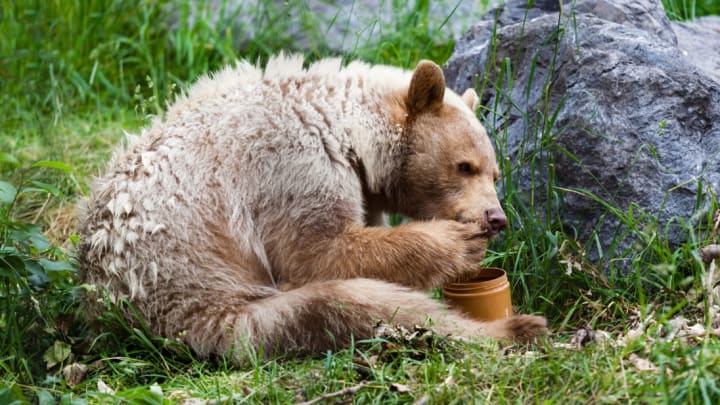If your experience with bears is largely limited to reading Winnie the Pooh as a kid, you might think that these fuzzy mammals will do anything to get their gigantic paws on a jar of honey. And you wouldn’t necessarily be wrong. Author A. A. Milne didn’t pull his depiction of bears as honey-craving maniacs out of thin air. But their culinary tastes go beyond the sweet stuff in the hive.
“Bears do love honey and are attracted to beehives,” Elizabeth Manning, an education specialist for the State of Alaska, wrote for Alaska Fish & Wildlife News. “But unlike in Winnie the Pooh, the bears eat more than just honey. They will also consume the bees and larvae inside the beehive, which are a good source of protein. Both brown and black bears will raid beehives.”
If you’re wondering: Wouldn’t attacking a beehive result in a lots of painful bee stings? The answer is yes. According to the North American Bear Center:
“Bears endure stings to get the prized pupae, larvae, and eggs in the brood comb of a hive. Protective adult bees sting bears’ faces and ears but have a hard time penetrating the fur on the rest of the body. After bears get the brood comb and perhaps some honey, they hurry away and shake bees out of their fur like they shake water.”
In other words: bears think the tradeoff is worth it, which has caused major problems for beekeepers all over the world. In just the first five months of 2018, bears damaged more than 370 beehives throughout Finland and parts of Estonia, forcing Finland's government to shell out $143,000 to farmers whose livelihoods had been destroyed along with their hives.
While many beekeepers incur the cost of surrounding their hives with electric fencing to keep the bears at bay, even the sting of an electric shock isn't enough to deter the most determined bears. Last year in Finland, according to the BBC, a brown bear made its way right past an electric fence to get to two beehives.
After years of being pestered by bears, Ibrahim Sedef—a beekeeper in Turkey—has adopted an if-you-can’t-beat-‘em-join-‘em approach to dealing with the animals. Realizing that bears might be the most discerning honey-eaters around, he decided to turn the sweet-loving carnivores into voluntary taste testers. He set up four bowls, each one containing a different treat: flower honey, chestnut honey, Anzer honey, and cherry jam (as a decoy) to see if the bears sniffed out a particular favorite. Then he set up a camera and watched as they declared Anzer honey, which is one of the world’s most expensive honeys, to be the winner.
Anzer honey is the best, gourmets show... Highly recommended? https://t.co/WkDDy5GbDY
— Turkish Consulate Los Angeles (@TRConsuLA) August 21, 2019
While Sedef estimates that his bear problem has cost him about $10,000 over the years, he can’t stay mad at these furry guys. “Despite all this, when I see the footage, I forget all the harm they have done to me, and love them,” Sedef told The Guardian.
Have you got a Big Question you'd like us to answer? If so, let us know by emailing us at bigquestions@mentalfloss.com.
